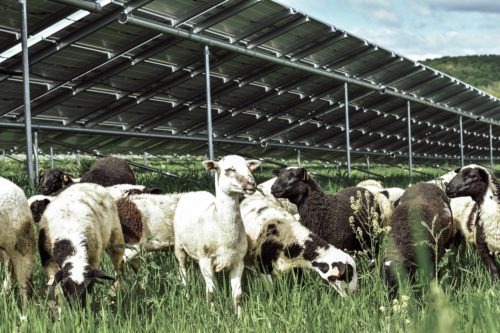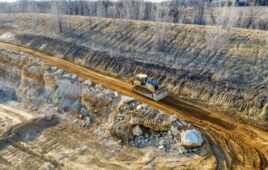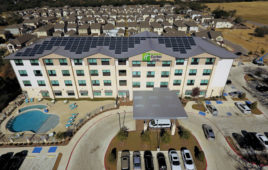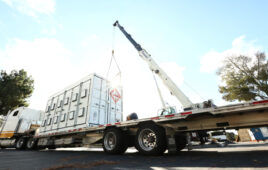Imagine a United States four years ago — there was a different president and there weren’t tariffs on solar panels. An oasis really, except for one thing — “solar sheep” didn’t really exist yet. If 2020 has one positive trend, it’s all the developers and project owners hiring grazing animals to cut vegetative maintenance costs and further lower carbon footprints. If we can only choose between no tariffs or more solar sheep, give us what we want! More sheep!
 KDC Solar told Solar Power World back in 2016 that it was having difficulty finding anyone interested in providing sheep for its projects in New Jersey. But luckily one local shepherd reached out, and KDC saw the results immediately. Compared to paying $25,000 a year to mow a 26-acre solar site, a few dozen sheep only cost KDC $10,000. Over the life of a PPA, those savings add up, and more national developers took notice.
KDC Solar told Solar Power World back in 2016 that it was having difficulty finding anyone interested in providing sheep for its projects in New Jersey. But luckily one local shepherd reached out, and KDC saw the results immediately. Compared to paying $25,000 a year to mow a 26-acre solar site, a few dozen sheep only cost KDC $10,000. Over the life of a PPA, those savings add up, and more national developers took notice.
Coupled with the desire for more pollinator-friendly plants on projects, many projects owners are deploying holistic land use practices that include grazing animals, with the most popular four-legged eating machines being sheep. Sheep are excellent at vegetation maintenance because they eat almost anything that grows and they’re short enough to fit under panels and take advantage of their shade and shelter from the elements.
One of the first companies to set off the summer of 2019 as the season for solar sheep employment was community solar provider Nexamp. The company released 150 sheep on a 30-acre, 7.5-MW project in New York, and, following the project’s success, employed sheep on additional projects across the Northeast.
![]() “We no longer have gas-powered equipment running on the site, and we are able to provide a steady stream of income to the sheep farmers while the sheep enjoy a safe, healthy environment in which to graze,” said Zaid Ashai, Nexamp CEO, in a press release.
“We no longer have gas-powered equipment running on the site, and we are able to provide a steady stream of income to the sheep farmers while the sheep enjoy a safe, healthy environment in which to graze,” said Zaid Ashai, Nexamp CEO, in a press release.
C2 Energy also decided last year to scale up its solar sheep program after a successful pilot program on a 7-MW project in Florida. Now with sheep working on 10 projects totaling over 79 MW and 300 acres, C2 is testing more wildflower plantings to further limit mowing and improve pollinator habitats.
National developer Silicon Ranch last year launched third-party product Regenerative Energy that “combines clean electricity generation with carbon sequestration, ecosystem restoration and rural economic revitalization.” Silicon Ranch partnered with regenerative ranchers and local farmers to bring more grazing animals and diverse native plants to some of its operating solar farms, and the company plans to use its new standards on all new builds in the future.
Silicon Ranch hopes its Regenerative Energy verification methodology and third-party certification protocol will be adopted by other developers and project owners to give us what we want — fewer gas-guzzling mowers and more sheep!





How about using alpacas for grazing? Are there any health concerns for the livestock being around the electric producing solar panels? Thanks!
Good initiative, reduces carbon footprint and at the same time enhances livelihoods to the communities surrounding the project
I think it’s important to point out that no two sites are built exactly the same, so grazing costs vary. Comparing to mowing, while understandable, leaves out so many of the benefits of grazing. It improves the soil, it reduces risk to the solar asset, and it can strengthen the bond between communities and solar operators. Perhaps most importantly, it’s a smarter way to make use of the land. These sites can produce more than electricity. Solar sites can help produce wholesome, local, satisfying food for the community.
Planning your solar site for solar grazing is one key to success. With a grazing plan (a Prescribed Grazing Plan custom written for each solar site), a seed mix that is both grazing & solar friendly, and a managed system for the sheep, the sheep should thrive and shading should not be an issue for the panels. Sheep can outperform mowers and humans with weedeaters on all kinds of solar sites, but the rougher the terrain, the more this becomes clear. Getting in early with farmers in the community you are developing your project will increase your chances of success.
Sheep will also work well with pollinators in many settings – especially if that is a goal from the outset. Biodiversity and conservation grazing go hand in hand.
Our organization, the American Solar Grazing Association, strives to develop best practices for solar grazing, support the growing solar grazing community, and build this developing industry. Please join and support our efforts! http://www.solargrazing.org
And since you asked, no goats.
Yep. Even miniature goats can jump to amazing heights! On the other hand, they can eat stuff that sheep won’t touch.
We have large sheep operations in Wyoming that may be interested in this type of activity.
Should also consider goats; maybe better – not sure.
We have reported on goats being used before! The key is that they have to be small in stature so they’re less inclined to jump on the panels https://www.solarpowerworldonline.com/2016/08/dont-eat-solar-om-costs-leave-four-legs/
Goats are more likely to eat wires and jump on the modules (despite slope). We have seen this on some farm projects where goats got in to the array by accident. Their hoofs did crack several modules.